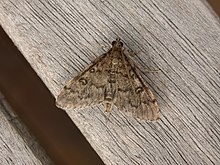
Metasia capnochroa is a species of moth of the family Crambidae described by Edward Meyrick in 1884. It is found in Australia, where it has been recorded from New South Wales, South Australia and Tasmania.

Metasia is a genus of moths of the family Crambidae. They are found mainly in Europe and Australia, but also in Africa, Asia, North America, and Pacific islands.

Metasia achroa is a species of moth of the family Crambidae described by Oswald Bertram Lower in 1903. It is known from Australia.

Metasia cuencalis is a species of moth in the family Crambidae. It is found in France, Spain and Portugal, as well as in North Africa, including Morocco.
Metasia harmodia is a moth in the family Crambidae. It was described by Edward Meyrick in 1887. It is found in Australia, where it has been recorded from Western Australia.
Metasia hemicirca is a moth in the family Crambidae. It was described by Edward Meyrick in 1887. It is found in Australia, where it has been recorded from Tasmania.
Metasia homogama is a moth in the family Crambidae. It was described by Edward Meyrick in 1887. It is found in Australia, where it has been recorded from Western Australia.
Metasia ochrochoa is a moth in the family Crambidae. It was described by Edward Meyrick in 1887. It is found in Australia, where it has been recorded from Queensland, the Northern Territory and New South Wales.
Metasia strangalota is a moth in the family Crambidae. It was described by Edward Meyrick in 1887. It is found in Australia, where it has been recorded from New South Wales.
Metasia xenogama is a moth in the family Crambidae. It was described by Edward Meyrick in 1884. It is found in the Australian states of South Australia and Western Australia.
Metasia alvandalis is a moth in the family Crambidae. It was described by Hans Georg Amsel in 1961 and is found in Iran.
Metasia delotypa is a moth in the family Crambidae. It was described by Turner in 1913. It is found in Australia, where it has been recorded from Queensland and New South Wales.
Metasia ectodontalis is a moth in the family Crambidae. It was described by Oswald Bertram Lower in 1903. It is found in Australia, where it has been recorded from Queensland.
Metasia homophaea is a moth in the family Crambidae. It was described by Edward Meyrick in 1885. It is found in Australia, where it has been recorded from New South Wales.
Metasia orphnopis is a moth in the family Crambidae. It was described by Turner in 1915. It is found in Australia, where it has been recorded from Queensland.
Metasia pharisalis is a moth in the family Crambidae. It was described by Francis Walker in 1859. It is found in Australia, where it has been recorded from Queensland.
Metasia triplex is a moth in the family Crambidae. It was described by Turner in 1913. It is found in Australia, where it has been recorded from Queensland.
Metasia typhodes is a moth in the family Crambidae. It was described by Turner in 1908. It is found in Australia, where it has been recorded from Queensland.

Metasia zinckenialis is a moth in the family Crambidae. It was described by George Hampson in 1899. It is found in Australia, where it has been recorded from Queensland.
Metasia zophophanes is a moth in the family Crambidae. It was described by Turner in 1937. It is found in Australia, where it has been recorded from Queensland.





